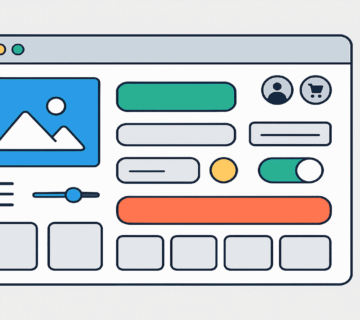The importance of website design
Introduction to Web Design
Web design is the process of creating and planning digital interfaces that present content on the internet. This process encompasses various elements related to aesthetics, user experience, and site functionality. Web design is significantly influenced by how users interact with content, making it a key factor in the success of any website. Designers must consider elements such as color schemes, typography, and layout—each playing a vital role in enhancing the overall user experience.
Colors are used in design to draw attention and convey specific emotions, while clear and readable fonts improve comprehension and ease of reading. Layout involves the logical organization of content, allowing users to navigate the site easily. Each design element requires careful attention to ensure a comfortable and efficient user journey.
Web design can generally be categorized into two main types: static and responsive websites. Static websites feature fixed layouts that do not adapt to screen sizes or devices, which can result in a subpar user experience across different devices. Responsive websites, on the other hand, adjust their layout and elements automatically based on screen size, ensuring an optimal experience on all devices—whether smartphones, tablets, or desktops. This distinction in design is essential in today’s world of constantly evolving devices and browsing technologies.

Impact of Web Design on User Experience
Web design is a critical factor in shaping the user experience. An effective and attractive design greatly improves navigation speed and access to information. Users are more likely to feel comfortable and stay longer on a well-designed site, where content is logically organized and easy to find.
Studies show that websites with clear design elements—such as prominent buttons and well-structured section headings—reduce the time needed to locate information. Conversely, poorly designed sites can frustrate users and drive them to seek alternative websites with better usability. This directly affects conversion rates; statistics indicate that improved user experience resulting from thoughtful design can significantly boost sales or subscriptions.
For example, an e-commerce website redesigned to streamline the purchasing process saw a notable increase in user engagement and conversion rates. In contrast, a website with a cluttered design made it difficult for users to find products, leading to a negative overall experience. These contrasting examples clearly demonstrate the powerful impact that design has on user satisfaction and interaction.
The Importance of Cross-Browser and Cross-Device Compatibility
Ensuring web design compatibility across different browsers and devices is a core component of any successful design strategy. In today’s digital age, users access websites from a wide range of devices, including smartphones, tablets, and laptops. This device diversity requires websites to be flexible and adaptive so users can access content easily and efficiently.
When users browse the internet, they expect websites to function seamlessly on all devices. Ensuring that designs are compatible across browsers reflects a brand’s professionalism and enhances the user experience. For instance, interface elements may display differently depending on the device, which can impact user interaction. Responsive design minimizes this issue by reducing bounce rates and encouraging user engagement.
Best practices for achieving responsive design include flexible grid layouts and ensuring that images and graphics load proportionally to screen size. Techniques such as CSS Media Queries allow designers to adjust styling based on the user’s device. Furthermore, prioritizing usability ensures that every environment provides a user-friendly interface.
Ultimately, designing websites to ensure cross-browser and cross-device compatibility not only improves engagement but also contributes to brand goals and builds customer loyalty.

Modern Web Design Trends
The web design industry is constantly evolving, with modern trends emerging to meet users’ growing needs and technological advancements. One such trend is the use of animations, which serve as effective tools to capture visitors’ attention and enhance user experience. Simple animations can add dynamic visual interest and help illustrate site functions, making interactions more intuitive and enjoyable.
Another prominent trend is AI-driven design. Artificial intelligence can deliver personalized user experiences by analyzing visitor data and behavior, enabling websites to offer tailored content. Integrating AI into web design is a key step toward creating more intelligent, adaptive, and user-focused interfaces.
Additionally, minimalistic design is gaining widespread popularity. This approach focuses on presenting information in a clear, easy-to-understand manner, helping users navigate websites effortlessly. Clean, uncluttered layouts also improve loading speed and overall user satisfaction—reducing bounce rates and increasing the chances of converting visitors into customers.
To stay updated with the latest design trends, web designers should follow industry blogs, attend design conferences, and explore case studies and creative projects. Collaborating with peers and experimenting with innovative ideas can enrich the design process and inspire fresh, creative solutions in the field.








No comment